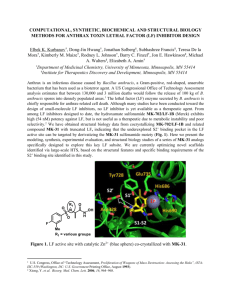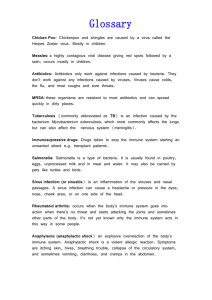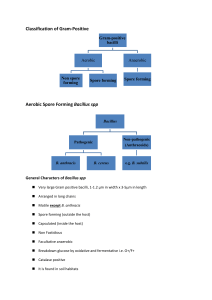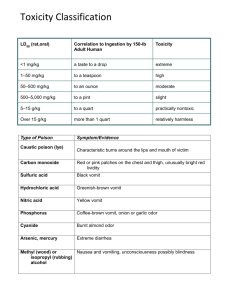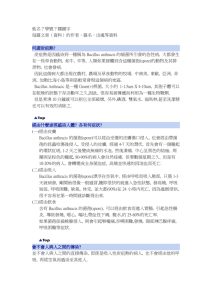x is primarily a disease of domesticated and wild animals
advertisement
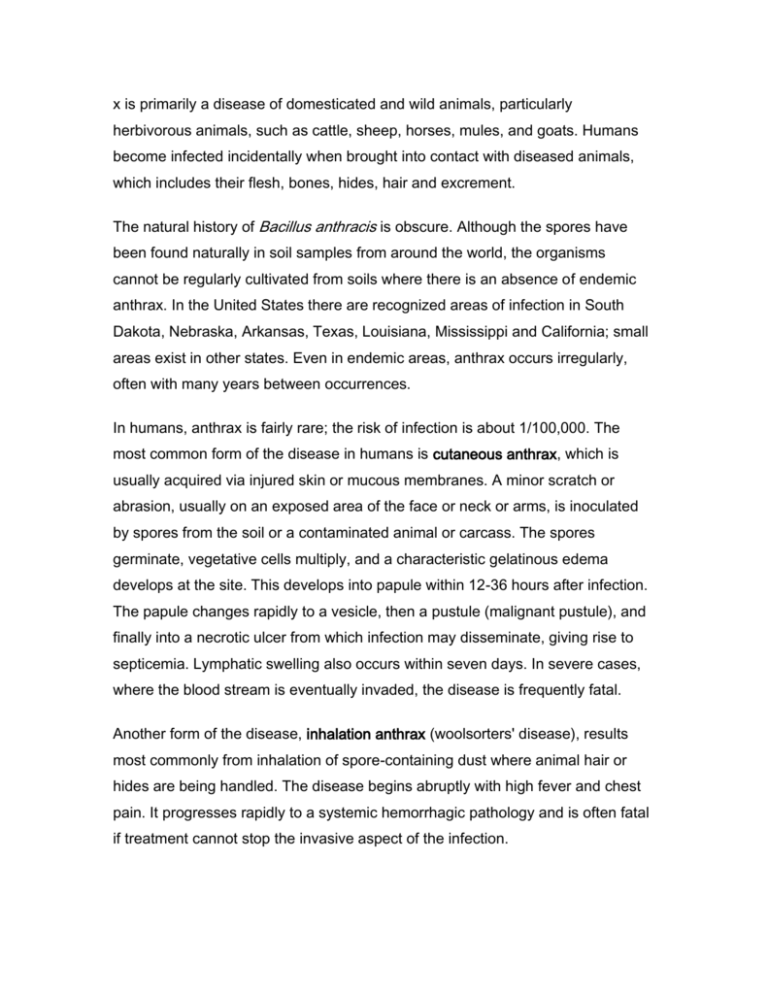
x is primarily a disease of domesticated and wild animals, particularly herbivorous animals, such as cattle, sheep, horses, mules, and goats. Humans become infected incidentally when brought into contact with diseased animals, which includes their flesh, bones, hides, hair and excrement. The natural history of Bacillus anthracis is obscure. Although the spores have been found naturally in soil samples from around the world, the organisms cannot be regularly cultivated from soils where there is an absence of endemic anthrax. In the United States there are recognized areas of infection in South Dakota, Nebraska, Arkansas, Texas, Louisiana, Mississippi and California; small areas exist in other states. Even in endemic areas, anthrax occurs irregularly, often with many years between occurrences. In humans, anthrax is fairly rare; the risk of infection is about 1/100,000. The most common form of the disease in humans is cutaneous anthrax, which is usually acquired via injured skin or mucous membranes. A minor scratch or abrasion, usually on an exposed area of the face or neck or arms, is inoculated by spores from the soil or a contaminated animal or carcass. The spores germinate, vegetative cells multiply, and a characteristic gelatinous edema develops at the site. This develops into papule within 12-36 hours after infection. The papule changes rapidly to a vesicle, then a pustule (malignant pustule), and finally into a necrotic ulcer from which infection may disseminate, giving rise to septicemia. Lymphatic swelling also occurs within seven days. In severe cases, where the blood stream is eventually invaded, the disease is frequently fatal. Another form of the disease, inhalation anthrax (woolsorters' disease), results most commonly from inhalation of spore-containing dust where animal hair or hides are being handled. The disease begins abruptly with high fever and chest pain. It progresses rapidly to a systemic hemorrhagic pathology and is often fatal if treatment cannot stop the invasive aspect of the infection. Gastrointestinal anthrax is analogous to cutaneous anthrax but occurs on the intestinal mucosa. As in cutaneous anthrax, the organisms probably invade the mucosa through a preexisting lesion. The bacteria spread from the mucosal lesion to the lymphatic system. Intestinal anthrax results from the ingestion of poorly cooked meat from infected animals. Intestinal anthrax, although extremely rare in developed countries, has an extremely high mortality rate. Meningitis due to B. anthracis is a very rare complication that may result from a primary infection elsewhere. Pathogenicity of Bacillus anthracis Poly-D-glutamyl capsule Bacillus anthracis forms a single antigenic type of capsule consisting of a poly-Dglutamate polypeptide. All virulent strains of B. anthracis form this capsule. Production of capsular material is associated with the formation of a characteristic mucoid or "smooth" colony type. "Smooth" (S) to "rough" (R) colonial variants occur, which is correlated with ability to produce the capsule. R variants are relatively avirulent. Capsule production depends on a 60 megadalton plasmid, pX02; its transfer to nonencapsulated B. anthracis via transduction produces the encapsulated phenotype. The poly-D-glutamyl capsule is itself nontoxic, but functions to protect the organism against the bactericidal components of serum and phagocytes, and against phagocytic engulfment. The capsule plays its most important role during the establishment of the infection, and a less significant role in the terminal phases of the disease, which are mediated by the anthrax toxin. The poly-D-glutamyl capsule is formed in vivo or in the laboratory when the bacterium is grown on serum plates in a 5% CO2 atmosphere. The capsular material is detected in the McFadyean reaction which involves staining with polychrome methylene blue. Blue rods in a background of purple/pink-stained capsular material is a positive test. Neither B. cereus nor B. thuringiensis synthesizes this capsular polymer, so the detection of capsular material can be used to distinguish B. anthracis from its closest relatives. McFadyean's reaction showing short chains of Bacillus anthracis cells lying among amorphous,disintegrated capsular material. White blood cells can also be seen. Anthrax Toxin The toxigenic properties of Bacillus anthracis were not recognized until 1954. Prior to that time, because of the tremendous number of anthrax bacilli observed in the blood of animals dying of the disease (109 bacteria/ml), it was assumed that death was due to blockage of the capillaries, popularly known as the "logjam" theory. But experimentally it was shown that only about 3 x 10 6 cells/ml are necessary to cause death of the animal. Furthermore, the cell-free plasma of animals dying of anthrax infection contained a toxin which causes symptoms of anthrax when injected into normal guinea pigs. These observations left little doubt that a diffusible exotoxin plays a major role in the pathogenesis of anthrax. One component of the anthrax toxin has a lethal mode of the action that is not understood at this time. Death is apparently due to oxygen depletion, secondary shock, increased vascular permeability, respiratory failure and cardiac failure. Death from anthrax in humans or animals frequently occurs suddenly and unexpectedly. The level of the lethal toxin in the circulation increases rapidly quite late in the disease, and it closely parallels the concentration of organisms in the blood. Production of the anthrax toxin is mediated by a temperature-sensitive plasmid, pX01, of 110 megadaltons. The toxin consists of three distinct antigenic components. Each component of the toxin is a thermolabile protein with a mw of approximately 80kDa. Factor I is the edema factor (EF) which is necessary for the edema producing activity of the toxin. EF is known to be an inherent adenylate cyclase, similar to the Bordetella pertussis adenylate cyclase toxin. Factor II is the protective antigen (PA), because it induces protective antitoxic antibodies in guinea pigs. PA is the binding (B) domain of the anthrax toxin which has two active (A) domains, EF (above) and LF (below). Factor III is known as the lethal factor (LF) because it is essential for the lethal effects of the anthrax toxin. Apart from their antigenicity, each of the three factors exhibits no significant biological activity in an animal. However, combinations of two or three of the toxin components yield the following results in experimental animals. PA+LF combine to produce lethal activity EF+PA produce edema EF+LF is inactive PA+LF+EF produces edema and necrosis and is lethal These experiments suggest that the anthrax toxin has the familiar A-B enzymatic-binding structure of bacterial exotoxins with PA acting as the B fragment and either EF or LF acting as the active A fragment. EF+PA has been shown to elevate cyclic AMP to extraordinary levels in susceptible cells. Changes in intracellular cAMP are known to affect changes in membrane permeability and may account for edema. In macrophages and neutrophils an additional effect is the depletion of ATP reserves which are needed for the engulfment process. Hence, one effect of the toxin may be to impair the activity of regional phagocytes during the infectious process. The effects of EF and LF on neutrophils have been studied in some detail. Phagocytosis by opsonized or heat-killed Bacillus anthracis cells is not inhibited by either EF or LF, but a combination of EF + LF inhibits engulfment of the bacteria and the oxidative burst in the pmns. The two toxin components also increased levels of cAMP in the neutrophils. These studies suggest that the two active components of the toxin, EF + LF, together increase host susceptibility to infection by suppressing neutrophil function and impairing host resistance. LF+PA have combined lethal activity as stated above. The lethal factor is a Zn++ dependent protease that induces cytokine production in macrophages and lymphocytes, but its mechanism of cytotoxicity is unknown. In summary, the virulence of Bacillus anthracis is attributable to three bacterial components: 1. Capsular material composed of poly-D-glutamate polypeptide 2. EF component of exotoxin 3. LF component of exotoxin Both the capsule and the anthrax toxin may play a role in the early stages of infection, through their direct effects on phagocytes. Virulent anthrax bacilli multiply at the site of the lesion. Phagocytes migrate to the area but the encapsulated organisms can resist phagocytic engulfment, or if engulfed, can resist killing and digestion. A short range effect of the toxin is its further impairment of phagocytic activity and its lethal effect on leukocytes, including phagocytes, at the site. After the organisms and their toxin enter the circulation, the systemic pathology, which may be lethal, will result. Bacillus anthracis coordinates the expression of its virulence factors in response to a specific environmental signal. Anthrax toxin proteins and the antiphagocytic capsule are produced in response to growth in increased atmospheric CO 2. This CO2 signal is thought to be of physiological significance for a pathogen which invades mammalian host tissues. http://microvet.arizona.edu/Courses/MIC420/lecture_notes/bacillus_anthracis/banthrax_ general.html
